University Report: NSB202 Indigenous Health Assignment
VerifiedAdded on 2022/11/14
|10
|2745
|187
Report
AI Summary
This report examines the health disparities between Indigenous and non-Indigenous communities, focusing on the 'Close the Gap' and 'Closing the Gap' campaigns. It analyzes the differing approaches and effectiveness of these programs, highlighting the involvement of various organizations and governmental bodies. The report delves into the roles of patient escorts and Aboriginal Hospital Liaison Officers (AHLOs) in providing culturally competent care and supporting Indigenous patients like Matt. It discusses the challenges faced by healthcare professionals in addressing cultural and linguistic barriers, emphasizing the importance of cultural awareness and sensitivity. The report concludes by underscoring the need for systematic application of knowledge and evidence-based funding procedures to reduce health inequalities and improve healthcare outcomes for Indigenous communities.
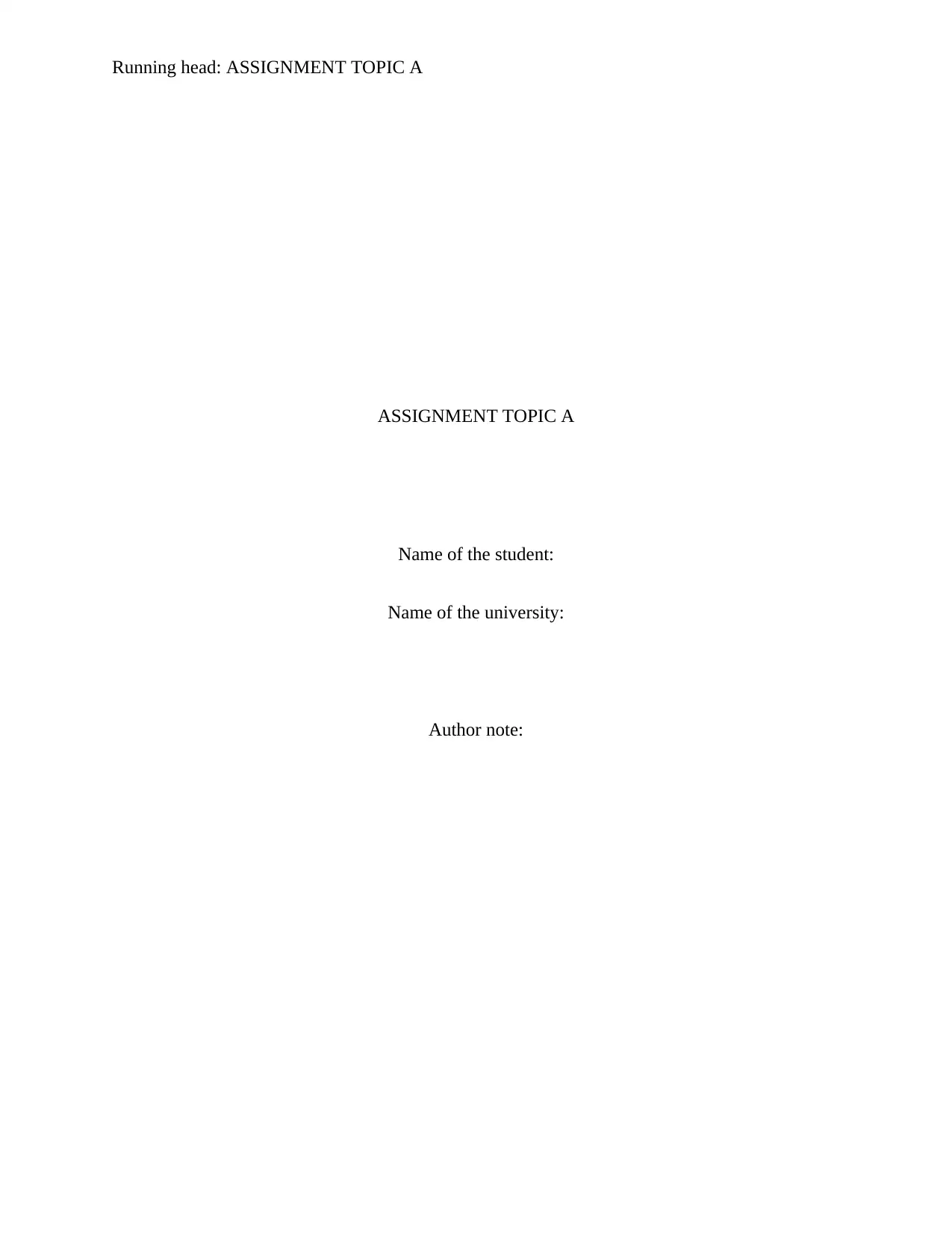
Running head: ASSIGNMENT TOPIC A
ASSIGNMENT TOPIC A
Name of the student:
Name of the university:
Author note:
ASSIGNMENT TOPIC A
Name of the student:
Name of the university:
Author note:
Paraphrase This Document
Need a fresh take? Get an instant paraphrase of this document with our AI Paraphraser
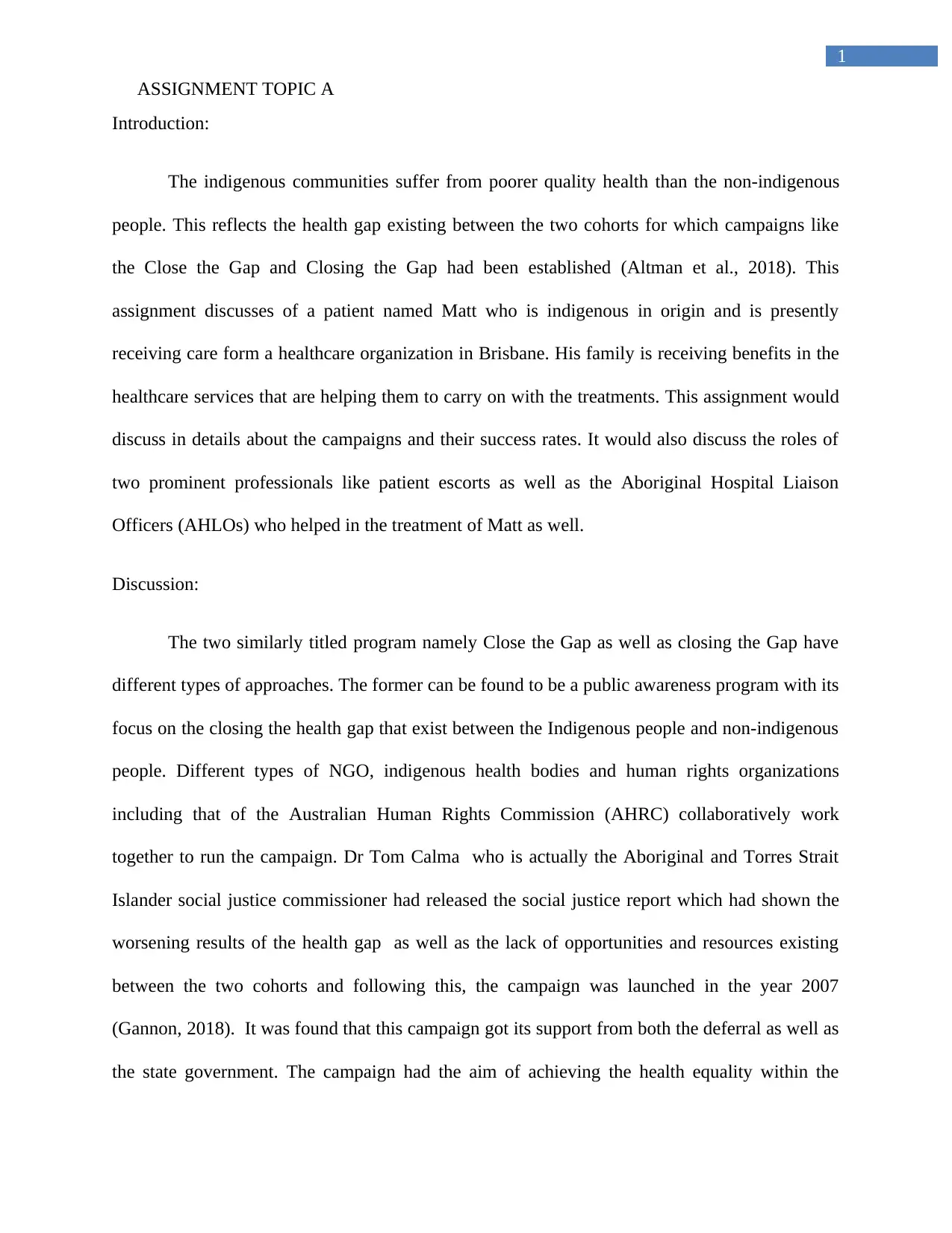
1
ASSIGNMENT TOPIC A
Introduction:
The indigenous communities suffer from poorer quality health than the non-indigenous
people. This reflects the health gap existing between the two cohorts for which campaigns like
the Close the Gap and Closing the Gap had been established (Altman et al., 2018). This
assignment discusses of a patient named Matt who is indigenous in origin and is presently
receiving care form a healthcare organization in Brisbane. His family is receiving benefits in the
healthcare services that are helping them to carry on with the treatments. This assignment would
discuss in details about the campaigns and their success rates. It would also discuss the roles of
two prominent professionals like patient escorts as well as the Aboriginal Hospital Liaison
Officers (AHLOs) who helped in the treatment of Matt as well.
Discussion:
The two similarly titled program namely Close the Gap as well as closing the Gap have
different types of approaches. The former can be found to be a public awareness program with its
focus on the closing the health gap that exist between the Indigenous people and non-indigenous
people. Different types of NGO, indigenous health bodies and human rights organizations
including that of the Australian Human Rights Commission (AHRC) collaboratively work
together to run the campaign. Dr Tom Calma who is actually the Aboriginal and Torres Strait
Islander social justice commissioner had released the social justice report which had shown the
worsening results of the health gap as well as the lack of opportunities and resources existing
between the two cohorts and following this, the campaign was launched in the year 2007
(Gannon, 2018). It was found that this campaign got its support from both the deferral as well as
the state government. The campaign had the aim of achieving the health equality within the
ASSIGNMENT TOPIC A
Introduction:
The indigenous communities suffer from poorer quality health than the non-indigenous
people. This reflects the health gap existing between the two cohorts for which campaigns like
the Close the Gap and Closing the Gap had been established (Altman et al., 2018). This
assignment discusses of a patient named Matt who is indigenous in origin and is presently
receiving care form a healthcare organization in Brisbane. His family is receiving benefits in the
healthcare services that are helping them to carry on with the treatments. This assignment would
discuss in details about the campaigns and their success rates. It would also discuss the roles of
two prominent professionals like patient escorts as well as the Aboriginal Hospital Liaison
Officers (AHLOs) who helped in the treatment of Matt as well.
Discussion:
The two similarly titled program namely Close the Gap as well as closing the Gap have
different types of approaches. The former can be found to be a public awareness program with its
focus on the closing the health gap that exist between the Indigenous people and non-indigenous
people. Different types of NGO, indigenous health bodies and human rights organizations
including that of the Australian Human Rights Commission (AHRC) collaboratively work
together to run the campaign. Dr Tom Calma who is actually the Aboriginal and Torres Strait
Islander social justice commissioner had released the social justice report which had shown the
worsening results of the health gap as well as the lack of opportunities and resources existing
between the two cohorts and following this, the campaign was launched in the year 2007
(Gannon, 2018). It was found that this campaign got its support from both the deferral as well as
the state government. The campaign had the aim of achieving the health equality within the
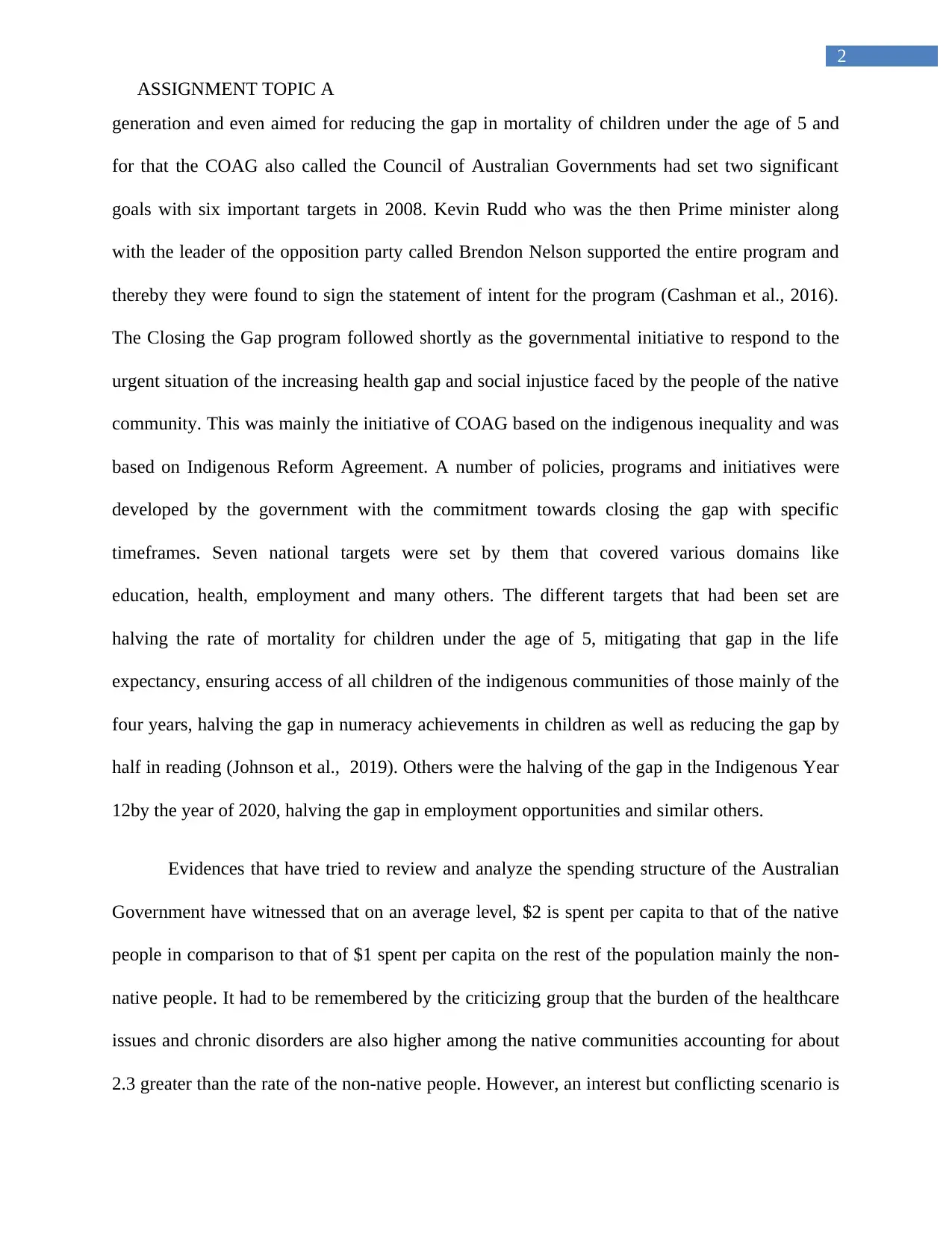
2
ASSIGNMENT TOPIC A
generation and even aimed for reducing the gap in mortality of children under the age of 5 and
for that the COAG also called the Council of Australian Governments had set two significant
goals with six important targets in 2008. Kevin Rudd who was the then Prime minister along
with the leader of the opposition party called Brendon Nelson supported the entire program and
thereby they were found to sign the statement of intent for the program (Cashman et al., 2016).
The Closing the Gap program followed shortly as the governmental initiative to respond to the
urgent situation of the increasing health gap and social injustice faced by the people of the native
community. This was mainly the initiative of COAG based on the indigenous inequality and was
based on Indigenous Reform Agreement. A number of policies, programs and initiatives were
developed by the government with the commitment towards closing the gap with specific
timeframes. Seven national targets were set by them that covered various domains like
education, health, employment and many others. The different targets that had been set are
halving the rate of mortality for children under the age of 5, mitigating that gap in the life
expectancy, ensuring access of all children of the indigenous communities of those mainly of the
four years, halving the gap in numeracy achievements in children as well as reducing the gap by
half in reading (Johnson et al., 2019). Others were the halving of the gap in the Indigenous Year
12by the year of 2020, halving the gap in employment opportunities and similar others.
Evidences that have tried to review and analyze the spending structure of the Australian
Government have witnessed that on an average level, $2 is spent per capita to that of the native
people in comparison to that of $1 spent per capita on the rest of the population mainly the non-
native people. It had to be remembered by the criticizing group that the burden of the healthcare
issues and chronic disorders are also higher among the native communities accounting for about
2.3 greater than the rate of the non-native people. However, an interest but conflicting scenario is
ASSIGNMENT TOPIC A
generation and even aimed for reducing the gap in mortality of children under the age of 5 and
for that the COAG also called the Council of Australian Governments had set two significant
goals with six important targets in 2008. Kevin Rudd who was the then Prime minister along
with the leader of the opposition party called Brendon Nelson supported the entire program and
thereby they were found to sign the statement of intent for the program (Cashman et al., 2016).
The Closing the Gap program followed shortly as the governmental initiative to respond to the
urgent situation of the increasing health gap and social injustice faced by the people of the native
community. This was mainly the initiative of COAG based on the indigenous inequality and was
based on Indigenous Reform Agreement. A number of policies, programs and initiatives were
developed by the government with the commitment towards closing the gap with specific
timeframes. Seven national targets were set by them that covered various domains like
education, health, employment and many others. The different targets that had been set are
halving the rate of mortality for children under the age of 5, mitigating that gap in the life
expectancy, ensuring access of all children of the indigenous communities of those mainly of the
four years, halving the gap in numeracy achievements in children as well as reducing the gap by
half in reading (Johnson et al., 2019). Others were the halving of the gap in the Indigenous Year
12by the year of 2020, halving the gap in employment opportunities and similar others.
Evidences that have tried to review and analyze the spending structure of the Australian
Government have witnessed that on an average level, $2 is spent per capita to that of the native
people in comparison to that of $1 spent per capita on the rest of the population mainly the non-
native people. It had to be remembered by the criticizing group that the burden of the healthcare
issues and chronic disorders are also higher among the native communities accounting for about
2.3 greater than the rate of the non-native people. However, an interest but conflicting scenario is
⊘ This is a preview!⊘
Do you want full access?
Subscribe today to unlock all pages.

Trusted by 1+ million students worldwide
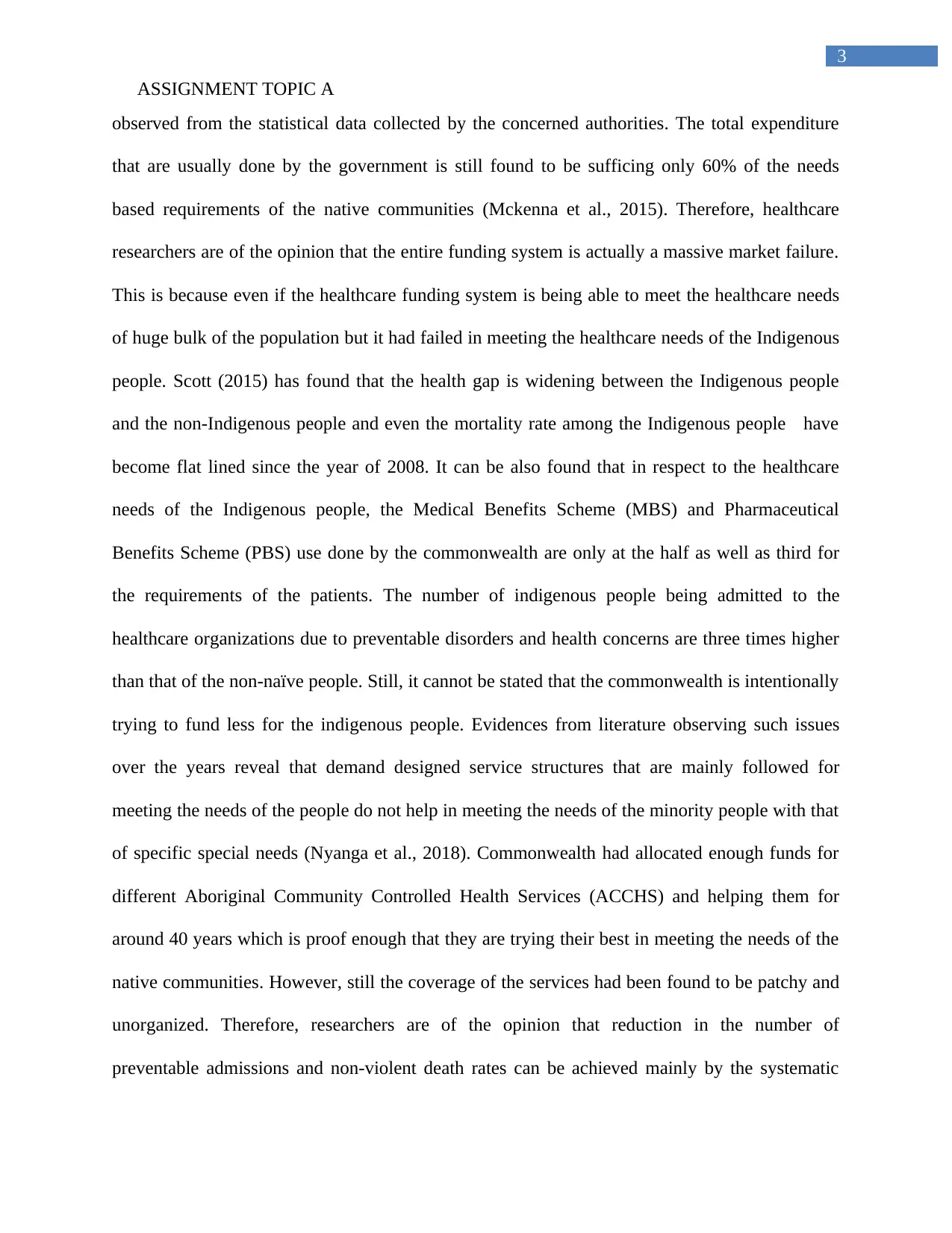
3
ASSIGNMENT TOPIC A
observed from the statistical data collected by the concerned authorities. The total expenditure
that are usually done by the government is still found to be sufficing only 60% of the needs
based requirements of the native communities (Mckenna et al., 2015). Therefore, healthcare
researchers are of the opinion that the entire funding system is actually a massive market failure.
This is because even if the healthcare funding system is being able to meet the healthcare needs
of huge bulk of the population but it had failed in meeting the healthcare needs of the Indigenous
people. Scott (2015) has found that the health gap is widening between the Indigenous people
and the non-Indigenous people and even the mortality rate among the Indigenous people have
become flat lined since the year of 2008. It can be also found that in respect to the healthcare
needs of the Indigenous people, the Medical Benefits Scheme (MBS) and Pharmaceutical
Benefits Scheme (PBS) use done by the commonwealth are only at the half as well as third for
the requirements of the patients. The number of indigenous people being admitted to the
healthcare organizations due to preventable disorders and health concerns are three times higher
than that of the non-naïve people. Still, it cannot be stated that the commonwealth is intentionally
trying to fund less for the indigenous people. Evidences from literature observing such issues
over the years reveal that demand designed service structures that are mainly followed for
meeting the needs of the people do not help in meeting the needs of the minority people with that
of specific special needs (Nyanga et al., 2018). Commonwealth had allocated enough funds for
different Aboriginal Community Controlled Health Services (ACCHS) and helping them for
around 40 years which is proof enough that they are trying their best in meeting the needs of the
native communities. However, still the coverage of the services had been found to be patchy and
unorganized. Therefore, researchers are of the opinion that reduction in the number of
preventable admissions and non-violent death rates can be achieved mainly by the systematic
ASSIGNMENT TOPIC A
observed from the statistical data collected by the concerned authorities. The total expenditure
that are usually done by the government is still found to be sufficing only 60% of the needs
based requirements of the native communities (Mckenna et al., 2015). Therefore, healthcare
researchers are of the opinion that the entire funding system is actually a massive market failure.
This is because even if the healthcare funding system is being able to meet the healthcare needs
of huge bulk of the population but it had failed in meeting the healthcare needs of the Indigenous
people. Scott (2015) has found that the health gap is widening between the Indigenous people
and the non-Indigenous people and even the mortality rate among the Indigenous people have
become flat lined since the year of 2008. It can be also found that in respect to the healthcare
needs of the Indigenous people, the Medical Benefits Scheme (MBS) and Pharmaceutical
Benefits Scheme (PBS) use done by the commonwealth are only at the half as well as third for
the requirements of the patients. The number of indigenous people being admitted to the
healthcare organizations due to preventable disorders and health concerns are three times higher
than that of the non-naïve people. Still, it cannot be stated that the commonwealth is intentionally
trying to fund less for the indigenous people. Evidences from literature observing such issues
over the years reveal that demand designed service structures that are mainly followed for
meeting the needs of the people do not help in meeting the needs of the minority people with that
of specific special needs (Nyanga et al., 2018). Commonwealth had allocated enough funds for
different Aboriginal Community Controlled Health Services (ACCHS) and helping them for
around 40 years which is proof enough that they are trying their best in meeting the needs of the
native communities. However, still the coverage of the services had been found to be patchy and
unorganized. Therefore, researchers are of the opinion that reduction in the number of
preventable admissions and non-violent death rates can be achieved mainly by the systematic
Paraphrase This Document
Need a fresh take? Get an instant paraphrase of this document with our AI Paraphraser
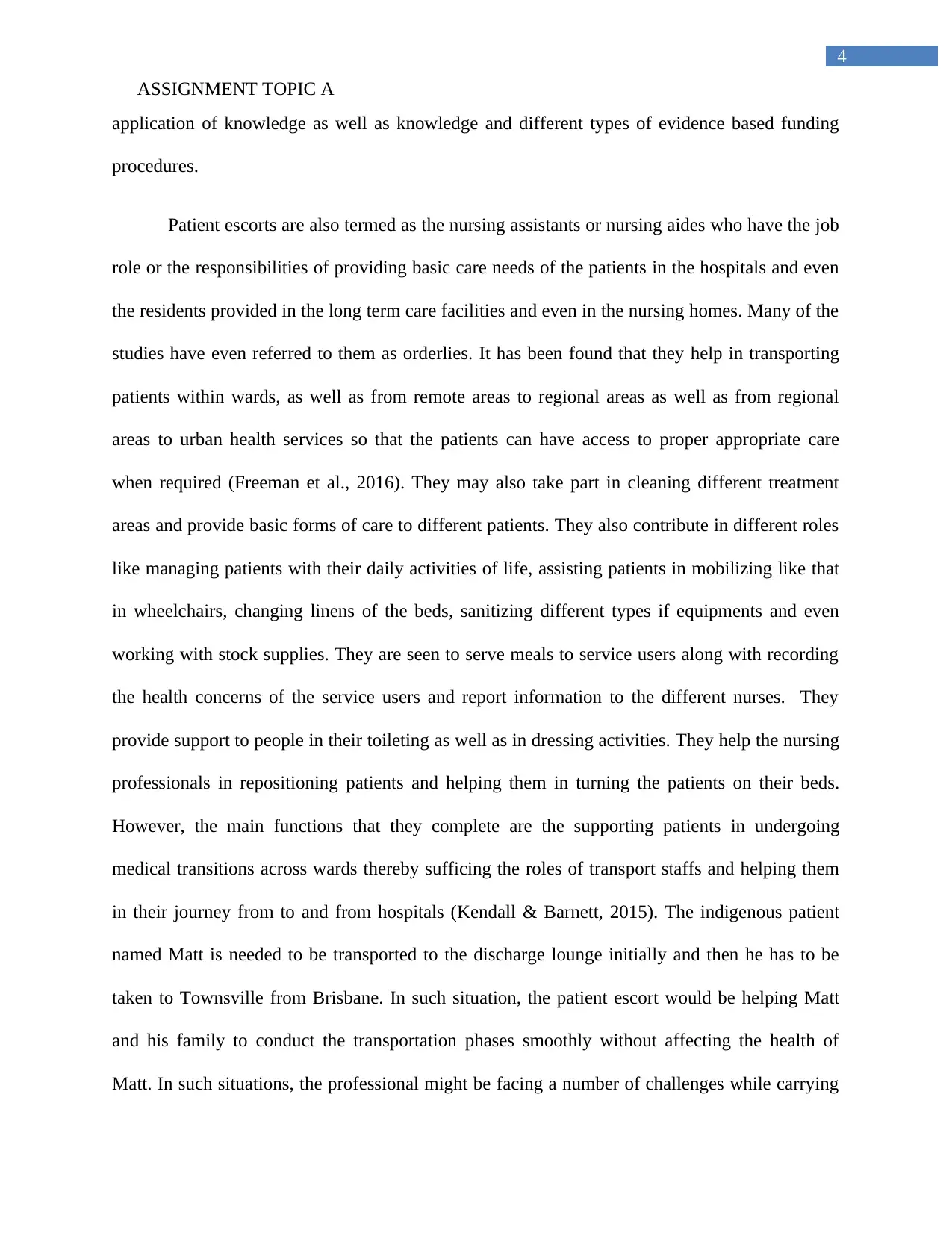
4
ASSIGNMENT TOPIC A
application of knowledge as well as knowledge and different types of evidence based funding
procedures.
Patient escorts are also termed as the nursing assistants or nursing aides who have the job
role or the responsibilities of providing basic care needs of the patients in the hospitals and even
the residents provided in the long term care facilities and even in the nursing homes. Many of the
studies have even referred to them as orderlies. It has been found that they help in transporting
patients within wards, as well as from remote areas to regional areas as well as from regional
areas to urban health services so that the patients can have access to proper appropriate care
when required (Freeman et al., 2016). They may also take part in cleaning different treatment
areas and provide basic forms of care to different patients. They also contribute in different roles
like managing patients with their daily activities of life, assisting patients in mobilizing like that
in wheelchairs, changing linens of the beds, sanitizing different types if equipments and even
working with stock supplies. They are seen to serve meals to service users along with recording
the health concerns of the service users and report information to the different nurses. They
provide support to people in their toileting as well as in dressing activities. They help the nursing
professionals in repositioning patients and helping them in turning the patients on their beds.
However, the main functions that they complete are the supporting patients in undergoing
medical transitions across wards thereby sufficing the roles of transport staffs and helping them
in their journey from to and from hospitals (Kendall & Barnett, 2015). The indigenous patient
named Matt is needed to be transported to the discharge lounge initially and then he has to be
taken to Townsville from Brisbane. In such situation, the patient escort would be helping Matt
and his family to conduct the transportation phases smoothly without affecting the health of
Matt. In such situations, the professional might be facing a number of challenges while carrying
ASSIGNMENT TOPIC A
application of knowledge as well as knowledge and different types of evidence based funding
procedures.
Patient escorts are also termed as the nursing assistants or nursing aides who have the job
role or the responsibilities of providing basic care needs of the patients in the hospitals and even
the residents provided in the long term care facilities and even in the nursing homes. Many of the
studies have even referred to them as orderlies. It has been found that they help in transporting
patients within wards, as well as from remote areas to regional areas as well as from regional
areas to urban health services so that the patients can have access to proper appropriate care
when required (Freeman et al., 2016). They may also take part in cleaning different treatment
areas and provide basic forms of care to different patients. They also contribute in different roles
like managing patients with their daily activities of life, assisting patients in mobilizing like that
in wheelchairs, changing linens of the beds, sanitizing different types if equipments and even
working with stock supplies. They are seen to serve meals to service users along with recording
the health concerns of the service users and report information to the different nurses. They
provide support to people in their toileting as well as in dressing activities. They help the nursing
professionals in repositioning patients and helping them in turning the patients on their beds.
However, the main functions that they complete are the supporting patients in undergoing
medical transitions across wards thereby sufficing the roles of transport staffs and helping them
in their journey from to and from hospitals (Kendall & Barnett, 2015). The indigenous patient
named Matt is needed to be transported to the discharge lounge initially and then he has to be
taken to Townsville from Brisbane. In such situation, the patient escort would be helping Matt
and his family to conduct the transportation phases smoothly without affecting the health of
Matt. In such situations, the professional might be facing a number of challenges while carrying
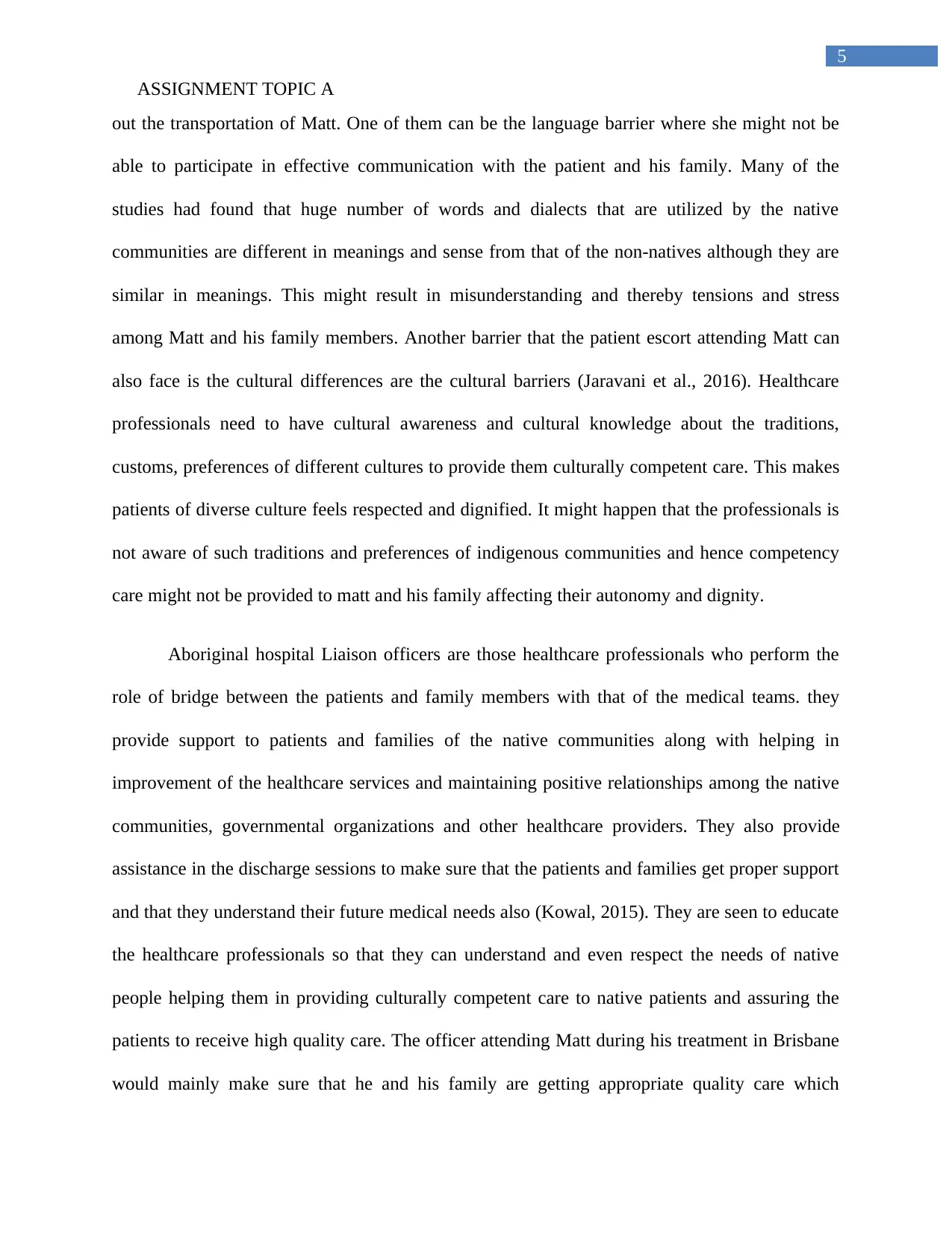
5
ASSIGNMENT TOPIC A
out the transportation of Matt. One of them can be the language barrier where she might not be
able to participate in effective communication with the patient and his family. Many of the
studies had found that huge number of words and dialects that are utilized by the native
communities are different in meanings and sense from that of the non-natives although they are
similar in meanings. This might result in misunderstanding and thereby tensions and stress
among Matt and his family members. Another barrier that the patient escort attending Matt can
also face is the cultural differences are the cultural barriers (Jaravani et al., 2016). Healthcare
professionals need to have cultural awareness and cultural knowledge about the traditions,
customs, preferences of different cultures to provide them culturally competent care. This makes
patients of diverse culture feels respected and dignified. It might happen that the professionals is
not aware of such traditions and preferences of indigenous communities and hence competency
care might not be provided to matt and his family affecting their autonomy and dignity.
Aboriginal hospital Liaison officers are those healthcare professionals who perform the
role of bridge between the patients and family members with that of the medical teams. they
provide support to patients and families of the native communities along with helping in
improvement of the healthcare services and maintaining positive relationships among the native
communities, governmental organizations and other healthcare providers. They also provide
assistance in the discharge sessions to make sure that the patients and families get proper support
and that they understand their future medical needs also (Kowal, 2015). They are seen to educate
the healthcare professionals so that they can understand and even respect the needs of native
people helping them in providing culturally competent care to native patients and assuring the
patients to receive high quality care. The officer attending Matt during his treatment in Brisbane
would mainly make sure that he and his family are getting appropriate quality care which
ASSIGNMENT TOPIC A
out the transportation of Matt. One of them can be the language barrier where she might not be
able to participate in effective communication with the patient and his family. Many of the
studies had found that huge number of words and dialects that are utilized by the native
communities are different in meanings and sense from that of the non-natives although they are
similar in meanings. This might result in misunderstanding and thereby tensions and stress
among Matt and his family members. Another barrier that the patient escort attending Matt can
also face is the cultural differences are the cultural barriers (Jaravani et al., 2016). Healthcare
professionals need to have cultural awareness and cultural knowledge about the traditions,
customs, preferences of different cultures to provide them culturally competent care. This makes
patients of diverse culture feels respected and dignified. It might happen that the professionals is
not aware of such traditions and preferences of indigenous communities and hence competency
care might not be provided to matt and his family affecting their autonomy and dignity.
Aboriginal hospital Liaison officers are those healthcare professionals who perform the
role of bridge between the patients and family members with that of the medical teams. they
provide support to patients and families of the native communities along with helping in
improvement of the healthcare services and maintaining positive relationships among the native
communities, governmental organizations and other healthcare providers. They also provide
assistance in the discharge sessions to make sure that the patients and families get proper support
and that they understand their future medical needs also (Kowal, 2015). They are seen to educate
the healthcare professionals so that they can understand and even respect the needs of native
people helping them in providing culturally competent care to native patients and assuring the
patients to receive high quality care. The officer attending Matt during his treatment in Brisbane
would mainly make sure that he and his family are getting appropriate quality care which
⊘ This is a preview!⊘
Do you want full access?
Subscribe today to unlock all pages.

Trusted by 1+ million students worldwide
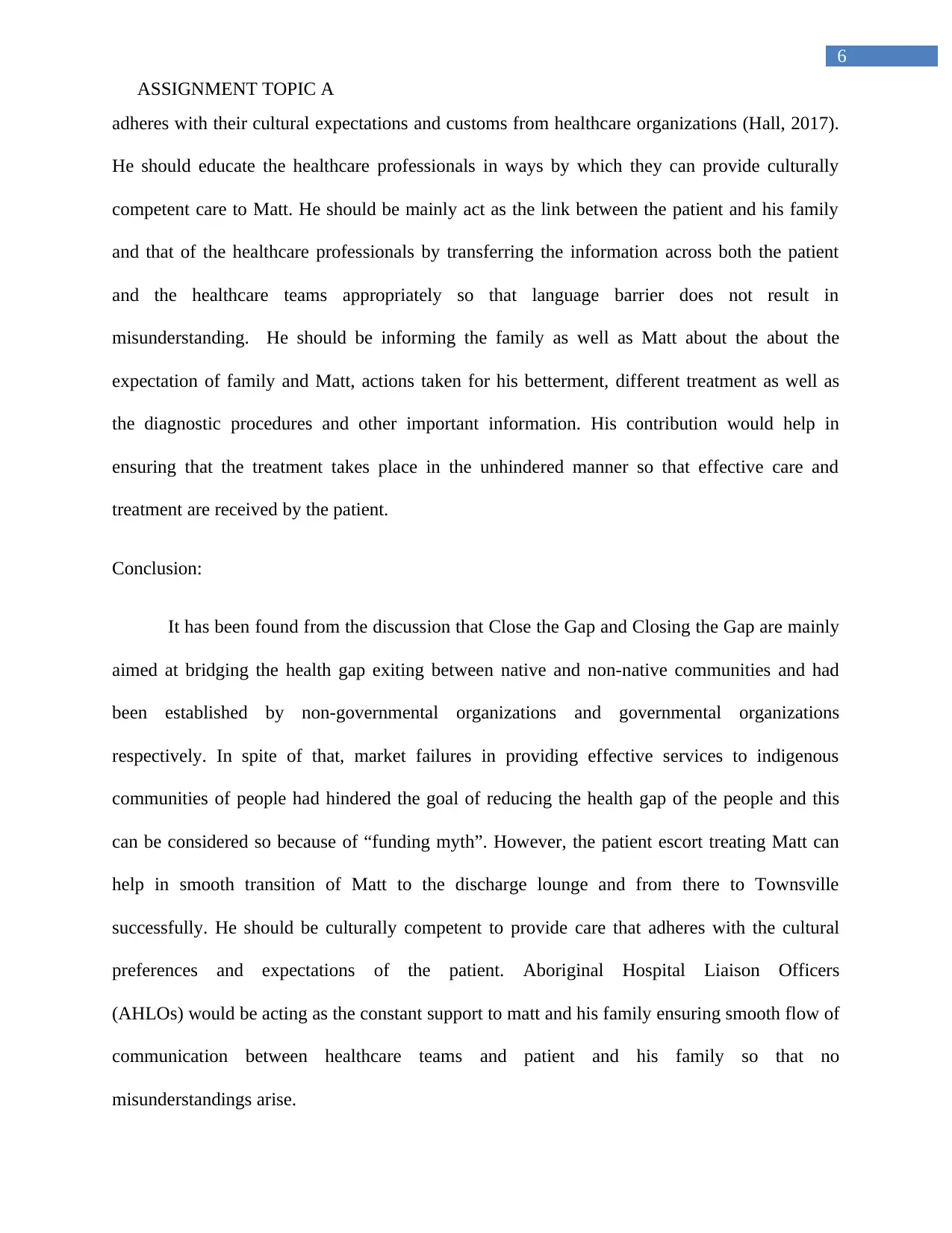
6
ASSIGNMENT TOPIC A
adheres with their cultural expectations and customs from healthcare organizations (Hall, 2017).
He should educate the healthcare professionals in ways by which they can provide culturally
competent care to Matt. He should be mainly act as the link between the patient and his family
and that of the healthcare professionals by transferring the information across both the patient
and the healthcare teams appropriately so that language barrier does not result in
misunderstanding. He should be informing the family as well as Matt about the about the
expectation of family and Matt, actions taken for his betterment, different treatment as well as
the diagnostic procedures and other important information. His contribution would help in
ensuring that the treatment takes place in the unhindered manner so that effective care and
treatment are received by the patient.
Conclusion:
It has been found from the discussion that Close the Gap and Closing the Gap are mainly
aimed at bridging the health gap exiting between native and non-native communities and had
been established by non-governmental organizations and governmental organizations
respectively. In spite of that, market failures in providing effective services to indigenous
communities of people had hindered the goal of reducing the health gap of the people and this
can be considered so because of “funding myth”. However, the patient escort treating Matt can
help in smooth transition of Matt to the discharge lounge and from there to Townsville
successfully. He should be culturally competent to provide care that adheres with the cultural
preferences and expectations of the patient. Aboriginal Hospital Liaison Officers
(AHLOs) would be acting as the constant support to matt and his family ensuring smooth flow of
communication between healthcare teams and patient and his family so that no
misunderstandings arise.
ASSIGNMENT TOPIC A
adheres with their cultural expectations and customs from healthcare organizations (Hall, 2017).
He should educate the healthcare professionals in ways by which they can provide culturally
competent care to Matt. He should be mainly act as the link between the patient and his family
and that of the healthcare professionals by transferring the information across both the patient
and the healthcare teams appropriately so that language barrier does not result in
misunderstanding. He should be informing the family as well as Matt about the about the
expectation of family and Matt, actions taken for his betterment, different treatment as well as
the diagnostic procedures and other important information. His contribution would help in
ensuring that the treatment takes place in the unhindered manner so that effective care and
treatment are received by the patient.
Conclusion:
It has been found from the discussion that Close the Gap and Closing the Gap are mainly
aimed at bridging the health gap exiting between native and non-native communities and had
been established by non-governmental organizations and governmental organizations
respectively. In spite of that, market failures in providing effective services to indigenous
communities of people had hindered the goal of reducing the health gap of the people and this
can be considered so because of “funding myth”. However, the patient escort treating Matt can
help in smooth transition of Matt to the discharge lounge and from there to Townsville
successfully. He should be culturally competent to provide care that adheres with the cultural
preferences and expectations of the patient. Aboriginal Hospital Liaison Officers
(AHLOs) would be acting as the constant support to matt and his family ensuring smooth flow of
communication between healthcare teams and patient and his family so that no
misunderstandings arise.
Paraphrase This Document
Need a fresh take? Get an instant paraphrase of this document with our AI Paraphraser

7
ASSIGNMENT TOPIC A
References:
Altman, J., Biddle, N., & Hunter, B. (2018). How realistic are the prospects for'closing the gaps'
in socioeconomic outcomes for Indigenous Australians?. Canberra, ACT: Centre for
Aboriginal Economic Policy Research (CAEPR), The Australian National University.
https://openresearch-repository.anu.edu.au/handle/1885/147387
Cashman, P. M., Allan, N. A., Clark, K. K., Butler, M. T., Massey, P. D., & Durrheim, D. N.
(2016). Closing the gap in Australian Aboriginal infant immunisation rates--the
development and review of a pre-call strategy. BMC public health, 16(1), 514.
https://doi.org/10.1186/s12889-016-3086-x
Freeman, T., Baum, F., Lawless, A., Labonté, R., Sanders, D., Boffa, J., ... & Javanparast, S.
(2016). Case study of an aboriginal community-controlled health service in Australia:
Universal, rights-based, publicly funded comprehensive primary health care in
action. Health and human rights, 18(2), 93.
https://www.ncbi.nlm.nih.gov/pmc/articles/PMC5394990/
Gannon, M. (2018). Indigenous health: Closing the gap-10 year review. Australian
Medicine, 30(3), 25.
https://search.informit.com.au/documentSummary;dn=480574352726957;res=IELAPA;t
ype=pdf
Hall, P. (2017). Educating to'close the gap'between indigenous and non-indigenous
Australia. Metaphor, (3), 6.
https://search.informit.com.au/documentSummary;dn=111827851527179;res=IELHSS
ASSIGNMENT TOPIC A
References:
Altman, J., Biddle, N., & Hunter, B. (2018). How realistic are the prospects for'closing the gaps'
in socioeconomic outcomes for Indigenous Australians?. Canberra, ACT: Centre for
Aboriginal Economic Policy Research (CAEPR), The Australian National University.
https://openresearch-repository.anu.edu.au/handle/1885/147387
Cashman, P. M., Allan, N. A., Clark, K. K., Butler, M. T., Massey, P. D., & Durrheim, D. N.
(2016). Closing the gap in Australian Aboriginal infant immunisation rates--the
development and review of a pre-call strategy. BMC public health, 16(1), 514.
https://doi.org/10.1186/s12889-016-3086-x
Freeman, T., Baum, F., Lawless, A., Labonté, R., Sanders, D., Boffa, J., ... & Javanparast, S.
(2016). Case study of an aboriginal community-controlled health service in Australia:
Universal, rights-based, publicly funded comprehensive primary health care in
action. Health and human rights, 18(2), 93.
https://www.ncbi.nlm.nih.gov/pmc/articles/PMC5394990/
Gannon, M. (2018). Indigenous health: Closing the gap-10 year review. Australian
Medicine, 30(3), 25.
https://search.informit.com.au/documentSummary;dn=480574352726957;res=IELAPA;t
ype=pdf
Hall, P. (2017). Educating to'close the gap'between indigenous and non-indigenous
Australia. Metaphor, (3), 6.
https://search.informit.com.au/documentSummary;dn=111827851527179;res=IELHSS
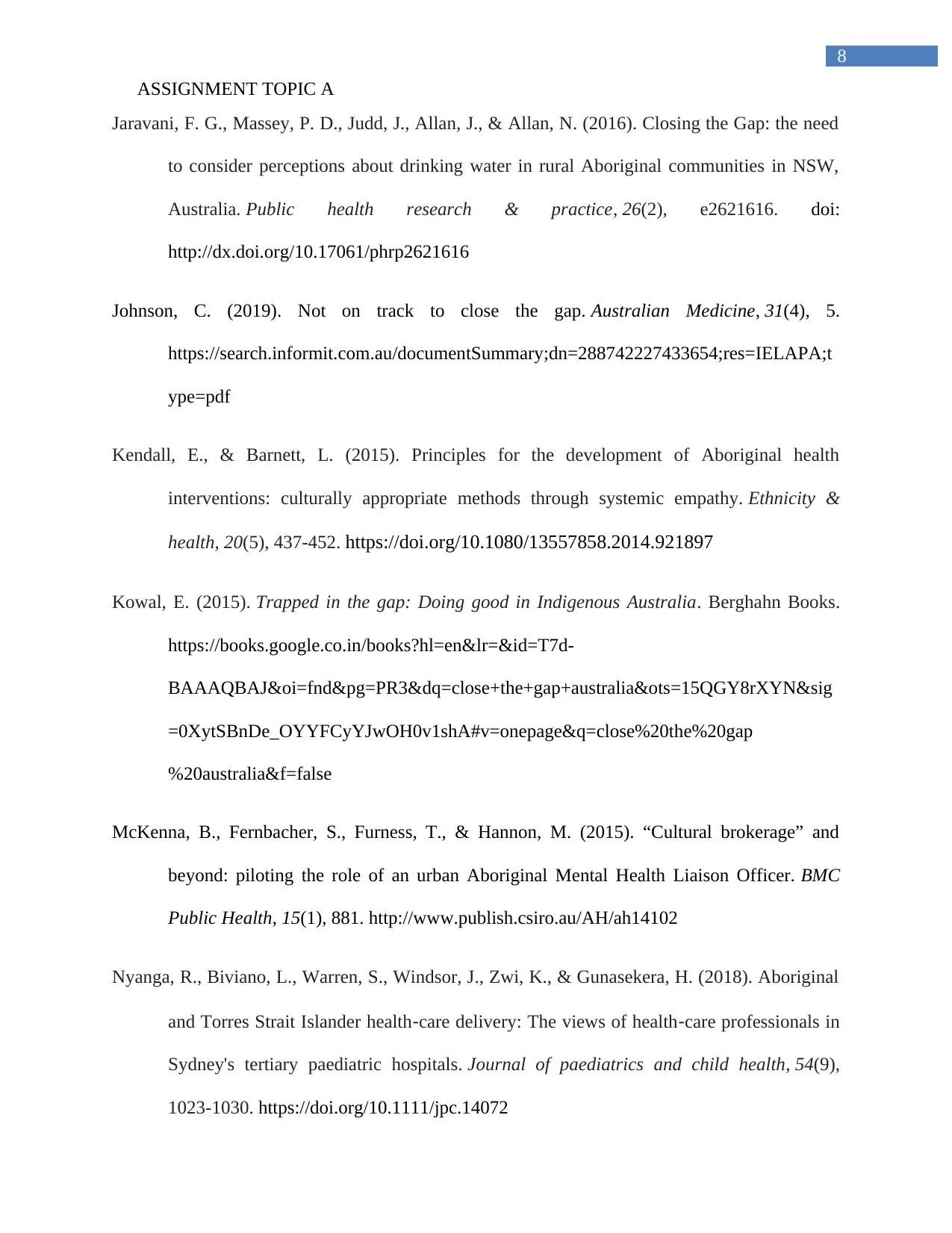
8
ASSIGNMENT TOPIC A
Jaravani, F. G., Massey, P. D., Judd, J., Allan, J., & Allan, N. (2016). Closing the Gap: the need
to consider perceptions about drinking water in rural Aboriginal communities in NSW,
Australia. Public health research & practice, 26(2), e2621616. doi:
http://dx.doi.org/10.17061/phrp2621616
Johnson, C. (2019). Not on track to close the gap. Australian Medicine, 31(4), 5.
https://search.informit.com.au/documentSummary;dn=288742227433654;res=IELAPA;t
ype=pdf
Kendall, E., & Barnett, L. (2015). Principles for the development of Aboriginal health
interventions: culturally appropriate methods through systemic empathy. Ethnicity &
health, 20(5), 437-452. https://doi.org/10.1080/13557858.2014.921897
Kowal, E. (2015). Trapped in the gap: Doing good in Indigenous Australia. Berghahn Books.
https://books.google.co.in/books?hl=en&lr=&id=T7d-
BAAAQBAJ&oi=fnd&pg=PR3&dq=close+the+gap+australia&ots=15QGY8rXYN&sig
=0XytSBnDe_OYYFCyYJwOH0v1shA#v=onepage&q=close%20the%20gap
%20australia&f=false
McKenna, B., Fernbacher, S., Furness, T., & Hannon, M. (2015). “Cultural brokerage” and
beyond: piloting the role of an urban Aboriginal Mental Health Liaison Officer. BMC
Public Health, 15(1), 881. http://www.publish.csiro.au/AH/ah14102
Nyanga, R., Biviano, L., Warren, S., Windsor, J., Zwi, K., & Gunasekera, H. (2018). Aboriginal
and Torres Strait Islander health‐care delivery: The views of health‐care professionals in
Sydney's tertiary paediatric hospitals. Journal of paediatrics and child health, 54(9),
1023-1030. https://doi.org/10.1111/jpc.14072
ASSIGNMENT TOPIC A
Jaravani, F. G., Massey, P. D., Judd, J., Allan, J., & Allan, N. (2016). Closing the Gap: the need
to consider perceptions about drinking water in rural Aboriginal communities in NSW,
Australia. Public health research & practice, 26(2), e2621616. doi:
http://dx.doi.org/10.17061/phrp2621616
Johnson, C. (2019). Not on track to close the gap. Australian Medicine, 31(4), 5.
https://search.informit.com.au/documentSummary;dn=288742227433654;res=IELAPA;t
ype=pdf
Kendall, E., & Barnett, L. (2015). Principles for the development of Aboriginal health
interventions: culturally appropriate methods through systemic empathy. Ethnicity &
health, 20(5), 437-452. https://doi.org/10.1080/13557858.2014.921897
Kowal, E. (2015). Trapped in the gap: Doing good in Indigenous Australia. Berghahn Books.
https://books.google.co.in/books?hl=en&lr=&id=T7d-
BAAAQBAJ&oi=fnd&pg=PR3&dq=close+the+gap+australia&ots=15QGY8rXYN&sig
=0XytSBnDe_OYYFCyYJwOH0v1shA#v=onepage&q=close%20the%20gap
%20australia&f=false
McKenna, B., Fernbacher, S., Furness, T., & Hannon, M. (2015). “Cultural brokerage” and
beyond: piloting the role of an urban Aboriginal Mental Health Liaison Officer. BMC
Public Health, 15(1), 881. http://www.publish.csiro.au/AH/ah14102
Nyanga, R., Biviano, L., Warren, S., Windsor, J., Zwi, K., & Gunasekera, H. (2018). Aboriginal
and Torres Strait Islander health‐care delivery: The views of health‐care professionals in
Sydney's tertiary paediatric hospitals. Journal of paediatrics and child health, 54(9),
1023-1030. https://doi.org/10.1111/jpc.14072
⊘ This is a preview!⊘
Do you want full access?
Subscribe today to unlock all pages.

Trusted by 1+ million students worldwide
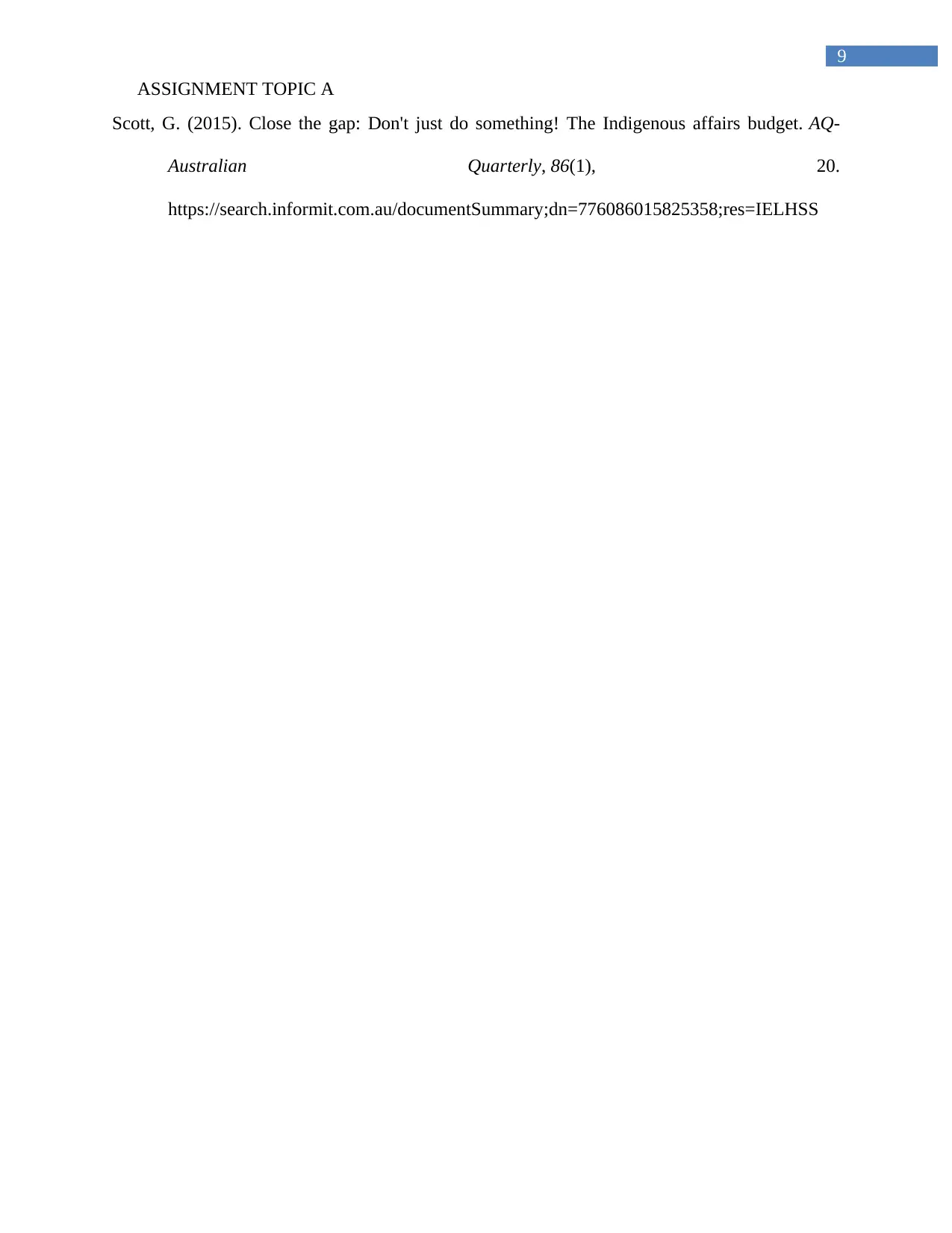
9
ASSIGNMENT TOPIC A
Scott, G. (2015). Close the gap: Don't just do something! The Indigenous affairs budget. AQ-
Australian Quarterly, 86(1), 20.
https://search.informit.com.au/documentSummary;dn=776086015825358;res=IELHSS
ASSIGNMENT TOPIC A
Scott, G. (2015). Close the gap: Don't just do something! The Indigenous affairs budget. AQ-
Australian Quarterly, 86(1), 20.
https://search.informit.com.au/documentSummary;dn=776086015825358;res=IELHSS
1 out of 10
Related Documents
Your All-in-One AI-Powered Toolkit for Academic Success.
+13062052269
info@desklib.com
Available 24*7 on WhatsApp / Email
![[object Object]](/_next/static/media/star-bottom.7253800d.svg)
Unlock your academic potential
Copyright © 2020–2025 A2Z Services. All Rights Reserved. Developed and managed by ZUCOL.





